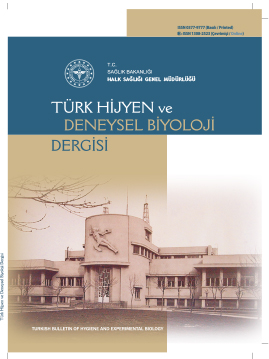
Bu eser Creative Commons Alıntı-GayriTicari-Türetilemez 4.0 Uluslararası Lisansı ile lisanslanmıştır.













Volume: 69 Issue: 2 - 2012
| RESEARCH ARTICLE | |
| 1. | Identification of respiratory viral infection agents by multiplex real-time PCR among children hospitalized for community-acquired pneumonia in Konya province Ahmet Sert, Recep Keşli, Dursun Odabaş, Hüseyin Bilgin, Ebru Aypar, Melike Keser, Abdullah Yazar, Muhammet Güzel Kurtoğlu, Fatih Akın doi: 10.5505/TurkHijyen.2012.74429 Pages 53 - 60 OBJECTIVE: Aim of this study was to evaluate the identification of viral pneumonia agents among children who were diagnosed and hospitalized for community-acquired pneumonia (CAP) by using molecular diagnostic techniques. METHODS: Sixty four children hospitalized for community-acquired pneumonia were included in the study in order to identify viral pneumonia agents in the province of Konya. The study was carried out in between October 2009 and December 2010. Nasopharyngeal smears were obtained from children patients aged 1 month to 8 years who were diagnosed as community-acquired pneumonia. Multiplex real time-Polymerase Chain Reaction (PCR) was performed for detection of existence of viral pneumonia agents such as respiratory syncytial virus (RSV), adenovirus, influenza and parainfluenza viruses on admission. RESULTS: Of all the 64 patients, 22 (34.4%) were positive for viral infections, 5 (7.7 %) were positive for bacterial infections, and 2 (3.1%) were positive for both viral and bacterial infections. A sole viral infection was identified in 20 (31.2%) and a sole bacterial infection in 3 (4.6%) cases. Influenza A virus (3.1%), parainfluenza type 1, 2, 3 viruses (3.1%), respiratory syncytial virus (23.4%) and adenovirus (4.6%) were found as causative viruses. Influenza B virus was not detected in any of cases. No possible etiologic agent was found in 37 cases (57.9%). Respiratory syncytial virus (23.4%) and adenovirus (4.6%) were the most commonly detected viral pathogens. There was no mortality during the study. CONCLUSION: This study showed that the viruses commonly detected as the causative agents of community-acquired pneumonia among the hospitalized children aged between 1 month and 8 years. Improving the etiological diagnosis of viral infections may definitely contribute to avoid unnecessary therapy, particularly antibiotics and allow for preventive isolation of infected patients. Performing more and new studies focusing on defining the role of viruses at the etiology of community-acquired pneumonia among hospitalized children will help establishment of true policies on the treatment of these patients. |
| 2. | Anti-HAV Seropositivity in Adult Patients With HBsAg positive From Various Locations of Turkey Mesut Ortatatlı, Ramazan Gümral, Hüseyin Üçkardeş, Levent Kenar doi: 10.5505/TurkHijyen.2012.05924 Pages 61 - 66 OBJECTIVE: This study aims to determine the rate of hepatitis A virus (HAV) seropositivity in adult HBsAg (+) patients from various regions of Turkey. METHODS: 137 adult (≥20 age) male patients admitted to Erzurum Mareşal Çakmak Military Hospital in 2009 who were previously diagnosed as HBsAg(+) were included. The subjects were not vaccinated for HAV. Serum samples were analyzed by EIA (enzyme immunassay) using Abbott/AxSYM. Chi-square test was used for statistical analysis of serological data. RESULTS: The Anti-HAV IgG (+) rates was 83.2% in the study populations (114/137), 61.5% (8/13) for those from Marmara region, 83.3% (13/16) for Mediterranean region, 84.6% (22/26) for Mid-Anatolian region, 66.7% (8/12) for Blacksea region, 87.5% (21/24) for East Anatolian region, 94.1% (32/34) for Southeast-Anatolian region. According to our study, no significant difference was found between seven geographical regions due to HAV seropozitivity rates (χ2= 9.511, p=0.147). The seven geographical regions were classified two main grups as East-Southeast Anatolia and other regions. The percentage of anti-HAV positivity rate was significantly higher in East- Southeast Anatolia grup (91.4%; 53/58) compared to other regions grup (77.2%; 61/79) (χ2= 4.803; p=0.028). CONCLUSION: The prevalance of Hepatitis A varies in different countries and even in different regions of a specific country. Age, low socioeconomic level and worse living conditions have been reported as the most important risk factors in studies with healthy individuals. In this study where subjects with HBsAg(+) were evaluated for anti-HAV positivity, an increase in the risk was found as OR =3.13 times larger (95% confidence interval, 1.09-9.01) when especially living conditions in East-Southeast Anatolia was compared with other regions. It has been postulated that all patients monitored for chronic HBV infection should be assessed for anti-HAV IgG and negative individuals need to be vaccinated due to higher mortality and more severe complications in HBsAg(+) patients. |
| 3. | In vitro activity of four different antibiotics against extended-spectrum β-lactamase producing Escherichia coli Abbas Yousefi Rad, Ali Özon, Salih Cesur doi: 10.5505/TurkHijyen.2012.30075 Pages 67 - 74 OBJECTIVE: Urinary tract infections due to wide spectrum ß-lactamase (GSBL) producing Escherichia coli strains are especially seen with increasing prevalence and may lead to complications with treatment insufficiencies. In patients having risk factors for GSBL producing microorganism, the selection of an appropriate ampirical treatment is important in preventing the complications that may be seen. In this study, MIC (minimum inhibition concentration) values of GSBL producing E. coli strains’ obtained from urine cultures, against tigecyclin, ertapenem, cefoperazone+ sulbactam (sulperazon) and levofloxacin antibiotics were aimed to be investigated. METHODS: In 2010, 87 GSBL producing E. coli strains isolated from urine cultures in TOBB ETÜ Hospital Clinical Microbiology Laboratory were identified with conventional methods. Antibiotic sensitivity tests were investigated by using Vitek-32 (BioMerieux, France). GBSL production of these strains was confirmed by double disc synergy test. Identified GSBL producing E.coli strains’ MIC levels and sensitivities against antibiotics were investigated by using E- Test. RESULTS: In GSBL producing E.coli strains, MIC of levofloxacin range of 0,01- >32 μg/ml and MIC range of sulperazon were found to be MIC range 0.190-128 μg/ml. MIC50 and MIC90 values of both antibiotics were found to be 12, ≥32, 12, 32 μg/ml. MIC range of tigecycline was found to be 0.190-25 μg/ml and MIC50 and MIC90 values were found to be 0.50-1 μg/ ml, respectively. MIC range of ertapenem was found to be 0,004-0,75 μg/ml and MIC50 and MIC90 values were found to be 0.047-0.250 μg/ml, respectively. In our study, while no resistance against ertapenem was found, 1.15% resistance in tigecycline, 10.3% resistance and 18.4% intermediate MIC level was found in sulperazon, and also 24.1% sensitive and 75.9% resistant strains were determined in levofloxacin. CONCLUSION: Due to the 75.9% resistivity ration detected in levofloxacin; for patients especially at risk for infection development with GSBL producing strains, it will be appropriate not to prefer quinolons for empirical treatment selection. In the treatment of these strains, ertapenem and tigecycline are seen as active choices. Due to 10.3% resistance and 18.4% intermediate MIC value detected in sulperazon, it may be preferred in appropriate patients according to sensitivity results. In infections caused by GSBL producing E. coli strains; initiation of appropriate and effective empirical treatment to the patients with risk factors belonging to these infections is important in regard to prevent the complications that may form. |
| 4. | Are we touches to water and soap? Ertuğrul Altınbilek, Cemil Kavalcı, Derya Öztürk, Oktay Hakbilir, Cem Akman, Müge Sönmez, Özgür Arslan doi: 10.5505/TurkHijyen.2012.03764 Pages 75 - 82 OBJECTIVE: In this study, we aimed to define effects of the endemic infective processes on the hand-washing habits of the emergency department staff in contact with the patients. METHODS: The study was prospectively conducted in Emergency Clinic of Ankara Numune Training and Research Hospital. Information recorded in the study forms consisted of the title of health care staff, type of the contact with the patients, whether the hands were washed before and after the contact with the patients, duration of the hand-washing, using soap or disinfectant, hand-drying, proper use of the glove and whether the gloves were destroyed in a proper way. Ki-kare test assay was used in the statistical analysis and p<0.05 values were considered significant. RESULTS: Following all the clean and dirty contacts, hand washing was made in 237 (28.9%) of total 819 contacts. Of the total 819 contacts, 538 (65.7%) were found to be clean and 281 (34.3%) dirty contacts. Incidence of the hand-washing was found as 84 times (15.6%) in 538 clean and 153 times (54.4%) in 281 dirty contacts. Frequency of the hand-washing was found higher in the dirty than in the clean contacts. Totally, 462 gloves were used during the study. When areas of use for 462 gloves were examined, it was observed that 219 gloves (47.4%) was used in the clean and 243 gloves (52.6%) in the dirty contacts. It was found during the observation that, soap was used in 134 (56.5%), while no soap was used in 103 (43.5%) of 237 hand-washing. Paper towel was defined to be used in 123 (51.9%) of 237. In addition, durations of the hand-washing following the clean and dirty contacts were also examined during the study. Durations of the hand-washing were found longer after the dirty than after the clean contacts. No significant difference was found between the genders in terms of the duration and incidence of the hand-washing. In the period before the study, number of the personnel who had experienced hospital-acquired infections was found higher than those had not experienced. CONCLUSION: In the emergency department in which the study was conducted, incidence of the hand-washing was found to be more than in the previous studies, but still it was not at a desired level. |
| 5. | Investigation of Francisella tularensis antibodies in dogs in Kars and Ankara Region Fatih Büyük, Mitat Şahin, Özgür Çelebi, Neriman Mor, Bekir Çelebi doi: 10.5505/TurkHijyen.2012.81488 Pages 83 - 88 OBJECTIVE: Tularemia, is a zoonotic disease with a wide variety of hosts caused by Francisella tularensis, that affects many animal species including mammals, birds and insects. Small rodents are the natural hosts, and blood-sucking ectoparasites are the most important vectors. Sheep are the most susceptible species to tularemia in domestic animals. Dogs play an important role in the epidemiology of tularemia, both as a reservoir carrying of the bacteria and as a host of ticks. In this study it was aimed to investigate of F. tularensis antibodies in sheepdog from the Kars region and pet dog from the Ankara region. METHODS: One hundred seventy one sheepdog blood serum samples from Kars region and 99 pet dog blood serum samples from Ankara region were examined in terms of F. tularensis antibodies with microagglutination test (MAT). F. tularensis antigen containing 0.005% safranin-O was used as the test antigen. Antibody titer of 1/80 or higher was considered as diagnostic titer with MAT. RESULTS: F. tularensis antibody titers were found as 1/80 and above in total of 11 (4.07%) dogs including 9 (5.3%) sheepdogs and 2 (2.0%) pet dogs. These serum samples were examined with Brucella canis antigen and were found negative for brucellosis. The difference of F. tularensis antibodies incidence between sheepdogs and pet dogs was found statistically insignificant (p>0.05). CONCLUSION: It was concluded that dogs may play a role at transmission of tularaemia to people, such studies would benefit for the elucidation of the epidemiology of the disease and should be increased of the number of them. |
| 6. | Analysis of Aflatoxin M1 by HPLC In Various Cheese Products Aysun Dinçel, Figen Demli, Fügen Durlu Özkaya, Filiz Alatan, Ramazan Uzun, Serdar Alp Subaşı doi: 10.5505/TurkHijyen.2012.78942 Pages 89 - 96 OBJECTIVE: Aflatoxins are a group of mycotoxin with potent carcinogenic, teratogenic, mutajenic and toxigenic effects are produced by certain species of Aspergillus flavus and Aspergillus parasiticus and may occur in various agricultural commodities. When aflatoxin B1 contaminates the food of lactating animals, milk from these animals contains aflatoxin M1, the principal metabolite arising from biotransformation of aflatoxin B1 in liver and it is secreted into milk in the mammary gland. In this study we aimed to determination and investigattion of aflatoxin M1 concentrations in cheese samples by HPLC. Samples were obtained from various regions of Turkey (Urfa, Civil, Mihalıç, Otlu cheese and Kars cheddar; n=100). METHODS: Aflatoxin M1 concentrations in cheese samples determined by using HPLC-RP fluorescence system (λex=365 nm and λem=435 nm) which were consisted of Phenomenex, Nucleosil, 100 A, C18 (4.6x250 mm, 5μm) analytical column and mobile phase composition with water: acetonitrile (75: 25 v/v) at 1 ml/min, 40 ºC). RESULTS: Aflatoxin M1 was determined only ten samples of Urfa cheese, which were under the acceptable limits of dairy products. In the other groups of cheese samples (Civil, Mihalıç, Otlu cheese and Kars cheddar) Aflatoxin M1 was not determined. CONCLUSION: In this study, Aflatoxin M1 was determined only ten samples of Urfa cheese which were under the acceptable limits of dairy products. All other samples from different part of the country were suitable for human consumption. Ancak bu konudaki çalışmaların daha geniş kapsamlı örneklerle tekrarlanması yanısıra gerek üreticilerin gerekse tüketicilerin konu hakkında bilgilendirilmesi önerilir. |
| REVIEW | |
| 7. | Molecular Responses of Plants to Stress Conditions İlker Büyük, Semra Soydam Aydın, Sümer Aras doi: 10.5505/TurkHijyen.2012.40316 Pages 97 - 110 Plants encounter many stress factors which affect their growth and development throughout their lifecycles because of their sessile nature. These stress conditions which can be originated by biotic and abiotic factors can adversely affect the quantity and quality of the product with leading to physiological and biochemical damage to crops. Plants have molecular response mechanisms for protecting and reducing negative effects of stress factors and these mechanisms can be divided in three groups, including homeostasis of ions and macromolecules, synthesis of protective molecules and formation and detoxification of reactive oxygen species (ROS). Homeostasis of macromolecules and ions is one of the response mechanisms of plants against dehydration and contains activation and inactivation of aquaporins and ion transport systems which play a role for controlling of water transmission and ion balance. The other stress response of plants is based on synthesis protective molecules such as low molecular weighted soluble substances or osmolites, heat shock (HSP) and LEA (late embroyogenesis abundont proteins) proteins. These molecules are participate in cell as an osmotic regulator and osmoprotectan. The last molecular responses of plants is the generation of enzymatic and non-enzymatic antioxidants which are responsible for synthesis and detoxificaiton of ROS under stress condition. Today, in biotechnology which has become one of the most popular research area, improving the adaptation and resistance of plants against stress conditions is primarily depends on a clear understanding of the effects of stress in plants. In this respect, increasing the sources and studies of stress molecular biology would be useful. |
| 8. | Similar structured carcinogen substances: Separation and determination of polychlorobiphenyls and organochloride pesticides Saadet Meral Karacan, Behice Yavuz Erdoğan, Atiye Nur Onar doi: 10.5505/TurkHijyen.2012.85619 Pages 111 - 119 Polychlorinated biphenyls (PCBs) and organochlorinated pesticides (OCPs) are organic molecules those contain one or more chlorine usually bonded to carbon atoms. In the past, while OCPs were widely used for agricultural purposes and in the fight against epidemic diseases, PCBs had an important area of usage in the industry because of their flame resistant property. The analogous chemical structure of polychlorinated biphenyls and organochlorinated pesticides leads accumulation of them in the same media of living organisms and the environment. The usages of polychlorinated biphenyls and organochlorinated pesticides have been prohibited in many countries due to their harmful effects in terms of human health and the environment. However, the presence of polychlorinated biphenyls and organochlorinated pesticides in the environment continues because of their highly resistant nature to chemical and biological degradation. There are few reported methods dealing with the simultaneous determination of polychlorinated biphenyls and organochlorinated pesticides in the literature. Frequently used techniques for the analysis of these compounds are gas chromatography (GC) and high-performance liquid chromatography (HPLC). The most commonly used technique for the analysis of both these compounds is gas chromatography with electron capture detector (GC-ECD) which is sensitive to chlorine containing compounds. However during the simultaneous analysis of PCBs and OCPs with GC-ECD, the signals overlap giving peaks at the same retention times in the chromatograms. The existence of PCBs as mixtures makes the problem more complex. In order to solve this problem, PCBs and OCPs had been either separated by extraction or by degradation of OCPs. In this article the chemical and physical properties of polychlorinated biphenyls and organochlorinated pesticides, their application areas, effects on the health and environment are explained. Then examples are presented for analysis of PCBs and OCPs individually. Methods developed for simultaneous determination of PCBs and OCPs are also described with a discussion of analytical problems. |


